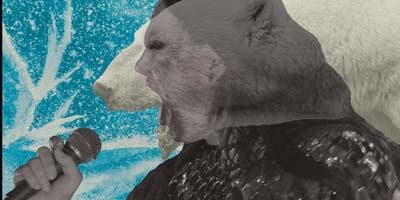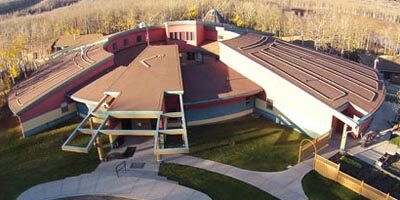 The deceased grandfather of Nikashant Antane, a young Innu man, came to him in a dream and said, “Get up and help your people.” So Antane, also called Michel Andrew but known in his community as “Giant,” started walking to raise awareness about diabetes in Innu settlements and to reconnect Innu youth with Nutshimi, the country.
The deceased grandfather of Nikashant Antane, a young Innu man, came to him in a dream and said, “Get up and help your people.” So Antane, also called Michel Andrew but known in his community as “Giant,” started walking to raise awareness about diabetes in Innu settlements and to reconnect Innu youth with Nutshimi, the country.
He started the Innu Cultural Health Walk in February 2009. Since then, the walk has covered more than 4000 kilometres across northeastern Quebec and Labrador, and has been growing in popularity. Giant has been to every Innu community on the Nitassinan during his walk for diabetes, covering more than 4000 kms since that first 500 km walk from Sheshatshiu to Natuashish. In October 2012 he walked to Pessamit, Quebec, the only Innu community he had not yet walked to in Quebec and Labrador.
His uncle, Alex Andrew, is the main organizer for the walk. He told me that the walk is an experience of self-healing, for both the individuals who take part and for the community as a whole. It empowers people who walk in memory of family members and others who suffer diabetes or addiction, as they return to the land where they have a deep knowledge and history.
The taiga, tundra and numerous waterways stretching between Innu communities in Labrador and north-eastern Quebec is called Nitassinan by the Innu. This rocky territory has been their home for more than 8,000 years. They were permanent migratory people until the 1950-60’s when they were forced into settlements by the Canadian government. These fixed settlements brought abrupt changes to their lifestyle and diet, and much of the Nitassinan became open to mining concessions and development. They brought unemployment, diabetes, alcoholism and abuse. The Innu became disconnected from Nitassinan, as their lifestyle became sedentary and away from the land.
Giant wants to help heal the inter-generational divide by leading young people back to the land. The walk also gives the opportunity for elders to reassume positions as teachers by passing on hunting and survival skills on the land, and teaching their culture and history.
“The walk is part of the process of cultural revitalization,” says Jules Pretty, a researcher on traditional lifestyles in Innu settlements at the University of Essex. “It provokes a pride about their place – their way of living and their history.”
Pretty says the walk is taking a leap forward; creating new hopes for people that have become seriously disconnected from their traditional lifestyles. He also says that the push away from the land did not happen very long ago; people were mobile until the mid-1960s, and this is a period that the older generation still remembers vividly.
I also spoke with Pretty’s colleague at the University of Essex, Colin Samson. They both are concerned about how the influx of processed and sugared foods into the settlements of Sheshatshiu and Natuashish drastically changed their diet from the diverse sources of lifestyle-appropriate food that Innu obtain from the land. For example, Innu obtain necessary fats and nutrients from caribou, ducks and geese in the spring, different types of fish like salmon, arctic char, lake trout, and porcupine in the winter; and a wide range of berries in fall and September.

The Innu walkers follow tracks across the frozen Nitassinan, setting up camps along the walk. Above, Michel Andrew (left) sets up camp with fellow Innu walkers. All photos by Dominick Tyler
These food sources supplied the calories and good fats necessary for operating snowmobiles and canoes after the ice breakup, and for hunting and migrating across the Nitassinan. However, many of the foods available in settlements are high in sugars and saturated fats; a direct result of globalization. As a result, Samson says, people’s health suffers. “Diabetes rates are directly related to abrupt changes in diet; from a wild food diet to a junk food diet.”
Giant’s walk is also important for younger generations because they are able to see evidence of past Innu migration across the Nitassinan, in the old campsites, canoes and arrowheads that give them a communal discovery of their history, which is largely ignored in the Canadian education system.
There is a strong spiritual connection that is awakened on the land, Samson said. “People will tell stories and talk about non-human presences on the land, and will tell you they’ve seen them more and talk about past times when they were seen. People who don’t have position and are unemployed in villages transform on the land. ”
Alex Andrew talked about the elders with tears in their eyes as they watched Giant return with Innu youth from their journey. “The elders were saying they look like caribou crossing the river with their white coats, like old times.” Libby Jay Chisholm is a recent graduate from the University of Guelph, where she completed a Bachelor of Arts Honours degree in Anthropology. She has researched and written articles regarding development and mining issues in Central America for organizations including Rights Action, and is interested in land sovereignty and First Nations issues in Canada.



